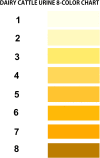Clinical utility of urine specific gravity, electrical conductivity, and color as on-farm methods for evaluating urine concentration in dairy cattle
- PMID: 31025445
- PMCID: PMC6524117
- DOI: 10.1111/jvim.15502
Clinical utility of urine specific gravity, electrical conductivity, and color as on-farm methods for evaluating urine concentration in dairy cattle
Abstract
Background: Urine concentration (UC) provides clinically useful information concerning hydration status and renal function of animals.
Objectives: To characterize the clinical performance of urine specific gravity measured by optical refractometry (USG-R ) or Multistix-SG urine reagent dipstick (USG-D ), urine electrical conductivity using an OAKTON Con 6 conductivity handheld meter (UEC ), urine color (UColor ) using a custom-designed 8-point color chart, and urine creatinine concentration (UCreat ) for assessing UC in dairy cattle.
Animals: 20 periparturient Holstein-Friesian cows.
Methods: Urine was obtained by perineal stimulation or urethral catheterization and urine osmolality (UOsm , reference method), USG-R , USG-D , UEC , UColor , and UCreat determined. Diagnostic test performance was evaluated using Spearman's rho and logistic regression to determine the area under the receiver operating curve (AUC) and optimal cut point for diagnosing hypohydration (UOsm ≥800 mOsm/kg). P < .05 was considered significant.
Results: The best performing test for diagnosing hypohydration was USG-R (AUC = 0.90) at an optimal cut point ≥1.030. The second-best performing test was UEC (AUC = 0.82) at a cut point of ≥23.7 mS/cm, followed by UCreat (AUC = 0.76) at a cut point of ≥95.3 mg/dL, and UColor (AUC = 0.74) at a cut point of ≥4 on an 8-point scale. Urine specific gravity measured by dipstick performed poorly (AUC = 0.63).
Conclusions and clinical importance: USG-R and UEC provide practical and sufficiently accurate methods for measuring UC in dairy cattle. Urine color had moderate clinical utility as a no-cost cow-side method for assessing UC, whereas dipstick refractometry is not recommended for assessing UC.
Keywords: bovine; dehydration; hypohydration; refractometer; urine color chart; urine creatinine; urine dipstick.
© 2019 The Authors. Journal of Veterinary Internal Medicine published by Wiley Periodicals, Inc. on behalf of the American College of Veterinary Internal Medicine.
Conflict of interest statement
Authors declare no conflict of interest.
Figures







References
-
- Thornton JR, English BP. Specific gravity and osmolality as measures of urine concentration in the calf. Aust Vet J. 1976;52:335‐337. - PubMed
-
- Silanikove N. The struggle to maintain hydration and osmoregulation in animals experiencing severe dehydration and rapid rehydration: the story of ruminants. Exp Physiol. 1994;79:281‐300. - PubMed
-
- Alcántara‐Isidro GJ, García‐Rodríguez MB, Diez‐Prietoa IM, et al. Urine concentration in healthy and diseased dairy cows during the first month after calving: comparison of the refractometry and reagent strip methods. J Vet Sci. 2015;1:34‐41.
-
- Chadha V, Garg U, Alon U. Measurement of urinary concentration: a critical appraisal of methodologies. Pediatr Nephrol. 2001;16:374‐382. - PubMed
-
- Ayoub JA, Beaufrere H, Acierno MJ. Association between urine osmolality and specific gravity in dogs and the effect of commonly measured urine solutes on that association. Am J Vet Res. 2013;74:1542‐1545. - PubMed
MeSH terms
Substances
LinkOut - more resources
Full Text Sources
Other Literature Sources
Medical

